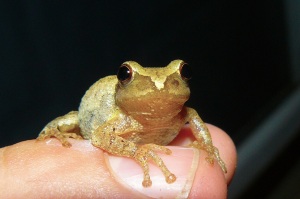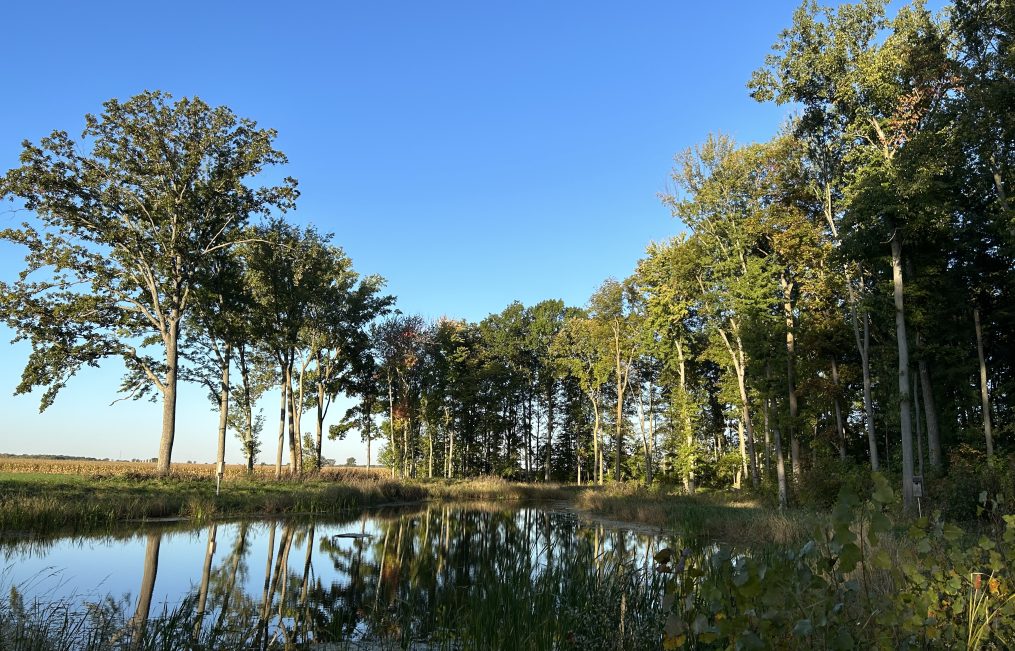“She tried very hard to teach her grandchildren how to extract the last drop of beauty out of all the small things of life, words and scents and sounds. Many little joys, weighed against the few heavy griefs of existence, could give some sort of balance to the scales and preserve the sanity of life.”
—The Bird in the Tree by Elizabeth Goudge
A writer friend who has four children – and one on the way – tells me she has been busy this summer – but not noisily so. “I’m busy,” she wrote, “trying to keep up with the daylight and plant all my plants and let the kids enjoy the summer.” Her busyness, she realized, has been steady and quiet, taking her often outside, where she has heard the songs of the Veery, Wood Thrush, and Yellow Warbler and savored summer-scented breezes, filling her with gratitude for where she lives.

Spring Peeper perched on the finger of the photographer’s hand. Photo by Francis.
I had asked her back when I was writing about being quiet at home whether she could share some thoughts about living quietly with children. Is such a thing possible in a society where children are kept busy and engaged with sound, devices, and activities so that summer becomes a frantic schedule of athletic events, camps, sports clinics, and lessons?
As I read my friend’s responses, it struck me that her family’s life has taken the shape it has not only because she and her husband sought and found a home where they can observe and be a part of the natural world, but because they have chosen to live in ways that defy our noisy, driven culture.
This didn’t start when they moved to a rural setting. Even when they lived in a city neighborhood, they had followed the advice of a contemplative nun to look for a house with a peaceful backyard. The one they found with a natural fence of pine shrubs and trees in a neighborhood with tall trees allowed their children to explore and establish early on a habit of discovering the outdoors.

A rose from the family’s garden. Photo by Francis.
Today, each of these children has his or her favorite thing to do outside. One especially enjoys birds, another walking the dog, and still another climbing trees. “All love to observe nature,” their mother says, “whether an iridescent beetle crawling across the driveway or finding horsehair worms (that I never even knew existed) in our yard, or seeing the amazingly beautiful small parts of a flower.” And they know the location of every bird’s nest within 200 feet of their house.
Key to their enjoyment of the outdoors, the peace of their home, and their development as individuals is a measured use of technology. This family watches a favorite college football team’s televised games, occasional videos, and sometimes nature programs, but for the most part, being outside, reading a book, or playing a musical instrument is encouraged over staring into an electronic screen.
When her children were younger, my friend confesses to being tempted to buy a “false peace” with too much TV. “‘Barney’ and ‘Thomas’ were much easier than listening to kids whine about something or grouch at each other. But what I noticed is that TV just made it worse later. It put off dealing with the problems. Now, we have many days where I want to throw them all outside to eat berries and roots – where I feel like a failure as a mom. But they are each discovering their own shortcomings, they know that they have to work at them, and they have, I think, a more honest view of themselves.” Better, she says, to help them work now on their issues – be it a tendency to be bossy and judgmental, not following through on tasks, or antagonizing siblings – instead of masking them with an electronic distraction and delaying their discovery until they are adults in the midst of difficult relationships.
By being given plenty of unstructured time, the oldest boy in this family has discovered and developed an interest in art and photography, as evidenced by his photos in this post. Likewise, his younger brother has found he is good at music and writing, especially poetry. The others are still exploring, even as they begin to show the first signs of a possible aptitude or interest.
In choosing to raise her family this way, my friend was helped by the example of a mother who would stop her weeding to show her children a bird stealing yarn out of the garden to put in its nest. “She would find frog eggs in the pond and have us watch them develop. She would catch flies and put them into spider webs so we could see how they wrapped them up in their thread. She loved to discover with us.“

Eastern Pondhawk Dragonfly. Photo by Francis.
It also helps that her husband joins her in keeping Sunday as a family day, going on hikes with the kids, and planning adventures for them in their kayaks and canoes. He even wants to build a zipline on their property.
My friend once heard a philosophy teacher say, “Why have our children stopped asking questions? Is it because they are so busy that they have no time to be still and look at the clouds and wonder?”
By choosing quiet over noise, and providing time to be outside and marvel at what is there to see, my friend and her husband are fostering wonder and discovery, helping their children learn about the world around them as well as the one within.
